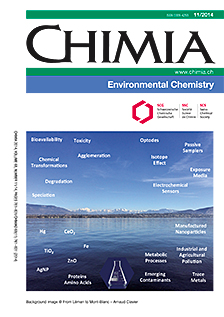Isotope Effects as New Proxies for Organic Pollutant Transformation
DOI:
https://doi.org/10.2533/chimia.2014.788Keywords:
Compound-specific isotope analysis, Degradation mechanism, Kinetic isotope effect, Pollutant transformationAbstract
Assessing the pathways and rates of organic pollutant transformation in the environment is a major challenge due to co-occurring transport and degradation processes. Measuring changes of stable isotope ratios (e.g. 13C/12C, 2H/1H, 15N/14N) in individual organic compounds by compound-specific isotope analysis (CSIA) makes it possible to identify degradation pathways without the explicit need to quantify pollutant concentration dynamics. The so-called isotope fractionation observed in an organic pollutant is related to isotope effects of (bio)chemical reactions and enables one to characterize pollutant degradation even if multiple processes take place simultaneously. Here, we illustrate some principles of CSIA using benzotriazole, a frequently observed aquatic micropollutant, as example. We show subsequently how the combined C and N isotope fractionation analysis of nitroaromatic compounds reveals kinetics and mechanisms of reductive and oxidative reactions as well as their (bio)degradation pathways in the environment.
Downloads
Published
Issue
Section
License
Copyright (c) 2014 Swiss Chemical Society

This work is licensed under a Creative Commons Attribution-NonCommercial 4.0 International License.







